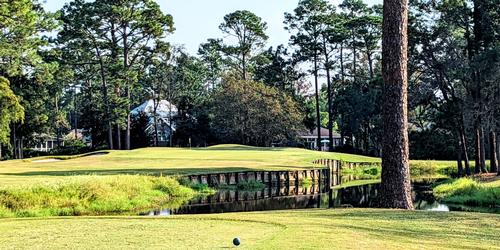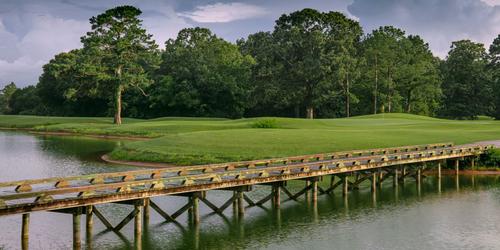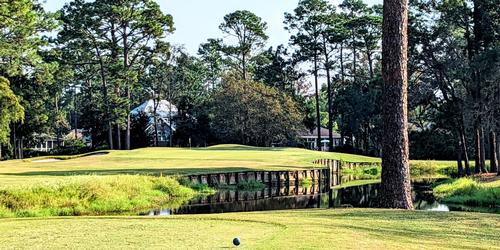
RT Jones Golf Trail
Strokes of Genius
By Bruce Leonard
As the CEO of the Retirement Systems of Alabama, Dr. Bronner conceived of, then enacted, the biggest golf course construction project in the world at the time. Today, the Robert Trent Jones Golf Trail includes 468 holes on 11 sites that stretch the length of the state, with all of the locations just minutes off of the major driving routes. Golfers come from around the world to play these courses created by one of golf's most renowned course architects. Why pay greens fees of $200, $300 and more to play other fancy courses, when the Trail delivers a week's worth of excellent golf for that kind of money? As I checked in at two different courses, I heard out-of-towners wondering how they could be reading the prices correctly in the pro shops. "Can that be right? Forty-five dollars to play a Robert Trent Jones course?" Yes, it's right for many reasons.
Three of the important lessons I learned during my week working my way south from Birmingham are: Travelers should not let the popularity of the "big" championship courses cause them to miss out on the wonders of the "short" courses. These short courses are as far from municipal "pitch-n-putt" courses as my game is from Jack Nicklaus'. Each and every hole I played on the Short Course at Grand National, in Auburn/Opelika, and on the Short Course at Magnolia Grove, in Mobile, would be a worthy addition to any of the championship courses along the Trail.
The second lesson I learned is to heed the signs on the first tees of the championship courses that caution golfers to play from tee boxes commensurate with their handicaps. These courses are far from pushovers. Water, for example, comes into play on 13 holes on the Judge Course, which plays to a slope of 144 from the back tees. Golfers should likely leave their egos at home, then move one tee box forward from the ones they usually play, or at least anticipate shooting significantly higher scores. I alternated between the front Teal tees and the Whites, and I scored exactly 10 strokes higher from the Whites.
And the third lesson I learned is to hydrate, hydrate, hydrate. The only aspect of my weeklong excursion that proved to be trying was that it occurred in the stultifying August heat. In April or October, it likely would have been perfect.
I began my RTJ Golf Trail foray in Birmingham on the Valley Course at Oxmoor Valley. The course provided a fine introduction to the extreme elevation changes evident on the Trail, as well allowing me to sample the slick, undulating greens that I would spend a week trying to conquer. Since I was easing my way in-and because I had lost all confidence in my driver, as well as plenty of balls, in my "practice rounds" elsewhere in Alabama before I reached the Trail-I kept my driver in the bag and played from the Teals. I barely broke 100. And the Teals have a slope of only 98. I was in for a challenging week.
Yet the next day's round had the potential to be embarrassing, because Ross Bridge, in Hoover, is the longest Par-72 course in the country. Sure, I would not be playing the Black back tees, which play to 8,191 yards and are reserved for golfers who are better than scratch, but I would still be playing a tough course with the Director of Golf. As I tossed and turned that night, I decided that I must take the big dog out of the bag, consequences be damned, and when I drove the ball long and straight the next morning on the 10th hole (the first hole that Chip Purser and I played), then managed to eek out a par, everything felt right with the world.
I have had rounds in which I've played far better; I've shared courses with family and friends, but I can say without any equivocation that I have never had a more enjoyable round of golf than the one I played that day at Ross Bridge. The course consists of 18 verdant postcards masquerading as golf holes. The fairways encourage aggression, since they are wide and forgiving, yet the demanding approach shots reminded me that scoring requires accuracy with one's irons. The course is filled with so many breathtaking, photo-worthy vistas that it almost seemed a shame to mar the perfection by taking a divot. The 9th and 18th holes wrap around the same shimmering body of water, creating such visually stunning endings to the front and back nines that the regal Renaissance Ross Bridge Golf Resort and Spa in the distance is nearly superfluous. At least from an aesthetic perspective.
From a luxury perspective, however, this resort is not to be missed. My lunch in the Club House, after my round, was far more delicious than any meal I had eaten so near a golf course, and my dinner that night in the onsite Mediterranean restaurant, Brock's, was among the top five meals I've eaten anywhere. After having my muscles soothed during a hot-stone massage at the Spa at Ross Bridge that evening, I completely understood how the resort was voted first in customer satisfaction by Renaissance guests worldwide and how Travel+Leisure included Ross Bridge among the world's Top 500 hotels.
Between lunch and dinner that day, I played the Oxmoor Valley Ridge Course, and it was the only course along the trail that I did not absolutely love. It is not likely the fault of the course, however, since more people play the Ridge Course than any other track in the state. Somewhere among its extreme elevation changes, though, I ran out of gas, which is why I enjoyed the hot-stone massage so thoroughly.
The next morning, as I drove the 120 miles or so toward Grand National, mostly southeast on US 280, I worried that I had begun the Trail at its most stellar point, and that I would be vaguely disappointed the rest of the way. What a wasted worry that proved to be. Grand National, with its Lakes Course, Links Course and Short Course, may be the one Trail stop to make, if travelers are foolish enough to make only one. Of the 54 holes, 32 of them wrap around Lake Saugahatchee, and the views are borderline distracting. At least that's the excuse I'm using for my play on the par-3 15th hole on the Lakes Course: The peninsula green helps make this hole perhaps the prettiest on the Trail, so I dutifully admired the setting while sacrificing two balls to the hole's beauty.
Golfers familiar with the Trail may argue that Capitol Hill, in Prattville, is the must-visit Trail stop, since it features three excellent championship courses, The Judge, The Senator and The Legislature. The awards and accolades for these courses are legion, with perhaps the most relevant being that Golf World readers named it the second-best public golf site in the country. Having played The Judge and The Senator, I understand why the former receives the lion's share of the attention (a tough-as-nails challenge) and why The Senator hosts the Navistar LPGA Classic each October (a superlative Scottish feel in the heart of the South). And after playing 36 holes, I felt a compelling need for, and was truly appreciative of, the deep-tissue massage at Renaissance Montgomery Hotel & Spa.
An hour or so southwest on I-65 delivered me to Cambrian Ridge, in Greenville. Choosing a favorite course along the Trail is beside the point, since the courses are not in competition with each other, and golfers can choose a course depending on their mood or the color of their golf pants. I, however, bought my only Trail souvenir at Cambrian Ridge, and I'm wearing that cap as I write this. The three championship nines are distinctive and visually alluring, but I think everyone who has the opportunity should play the Sherling nine: This route presents the best combination of opening-and-closing holes I played. The ninth features the most chilling tee shot I faced on the Trail, and the hat is a sartorial reminder that I managed to par the hole.
Travelers even vaguely interested in architecture or history should visit the Battle House, a Renaissance hotel and spa, in Mobile. Built in 1852, the property hosted luminaries and statesmen in its heyday, when it was the premier gathering place for high society. The renovated and first-rate establishment has obviously lowered its standards, however, since it allowed me to walk around and admire the place.
At nearby Magnolia Grove, which features two championship courses and a short course, all wending through a forest of hardwood and pine, I reminded myself on the Falls Course just how uplifting and humbling the game of golf can be. On the number-one handicap 15thhole, I smoked a drive to a blind landing area, lofted a solid 6-iron from the rough to an extremely elevated green, then made the 12-foot birdie putt: my single best-played hole along the Trail. Of course, this moment of transcendence was more than mitigated by the two 10s I carded that day. My score, which wouldn't have been bad had I been bowling, was not the course's fault.
Even travelers who have no allegiance to golf should find reason to visit the Grand Hotel Marriot Resort & Spa, in Point Clear, along Mobile Bay. This historic, family-friendly resort has been attracting visitors since 1847, and the food served onsite is certainly part of the allure. My dinner in the Grand Dining Room was the second best meal I've ever eaten and created the most pleasant memories.
Guests who stay at the Grand Hotel can play the two adjacent Trail courses, Dogwood and Azalea. Not designed by Robert Trent Jones but renovated by his principle designer (who also designed Ross Bridge), these courses are quality resort courses and play easier than the others along the Trail. I found the greens on Dogwood to be far more simple to read and putt on than any of the other courses. The greens fees at Lakewood Golf Club, as well as those at Ross Bridge, skew significantly higher than the greens fees along the rest of the Trail. Travelers should plan accordingly.
As I recount the wonders of the fantastic courses I played along the RTJ Golf Trail and cherish the memories those courses created, I remind myself that I only played about half of the Trail's holes ... so I better get cracking on a new itinerary.
Revised: 11/08/2011 - Article Viewed 34,546 Times
About: Bruce Leonard
![]() Bruce Leonard has been a freelance writer/photographer specializing in adventure travel for two decades, his work having been published in dozens of publications, including the Robb Report, Playboy, Travel+Leisure Golf, National Parks and the L.A. Weekly. His first solo art show recently closed, and his writing, photos and paintings can be found at freelanced.com/bruceleonard.
Bruce Leonard has been a freelance writer/photographer specializing in adventure travel for two decades, his work having been published in dozens of publications, including the Robb Report, Playboy, Travel+Leisure Golf, National Parks and the L.A. Weekly. His first solo art show recently closed, and his writing, photos and paintings can be found at freelanced.com/bruceleonard.











